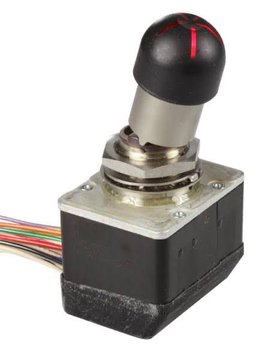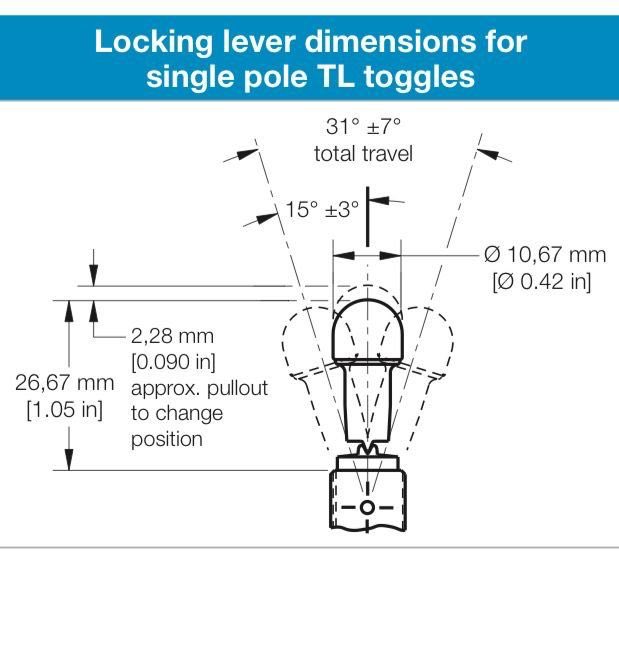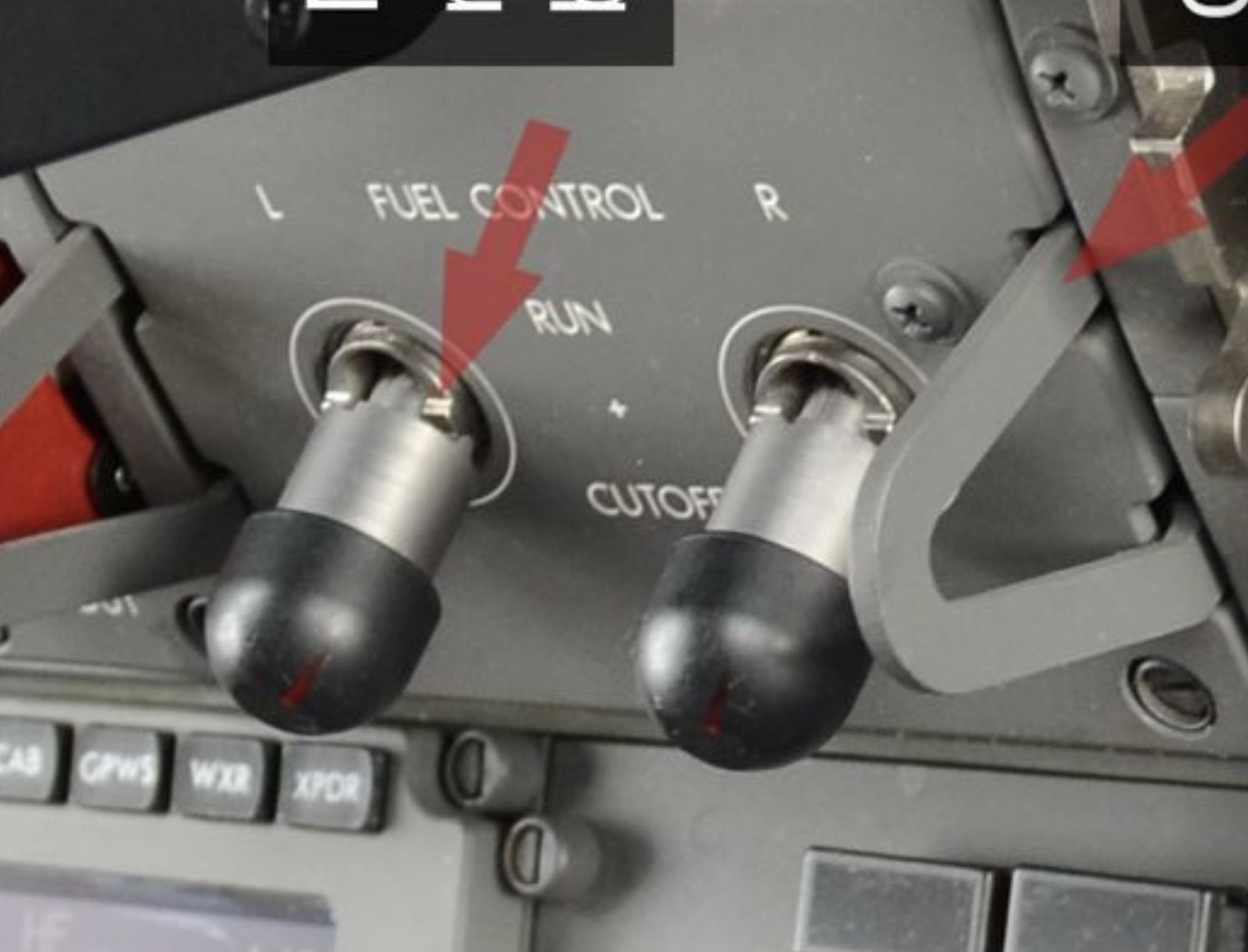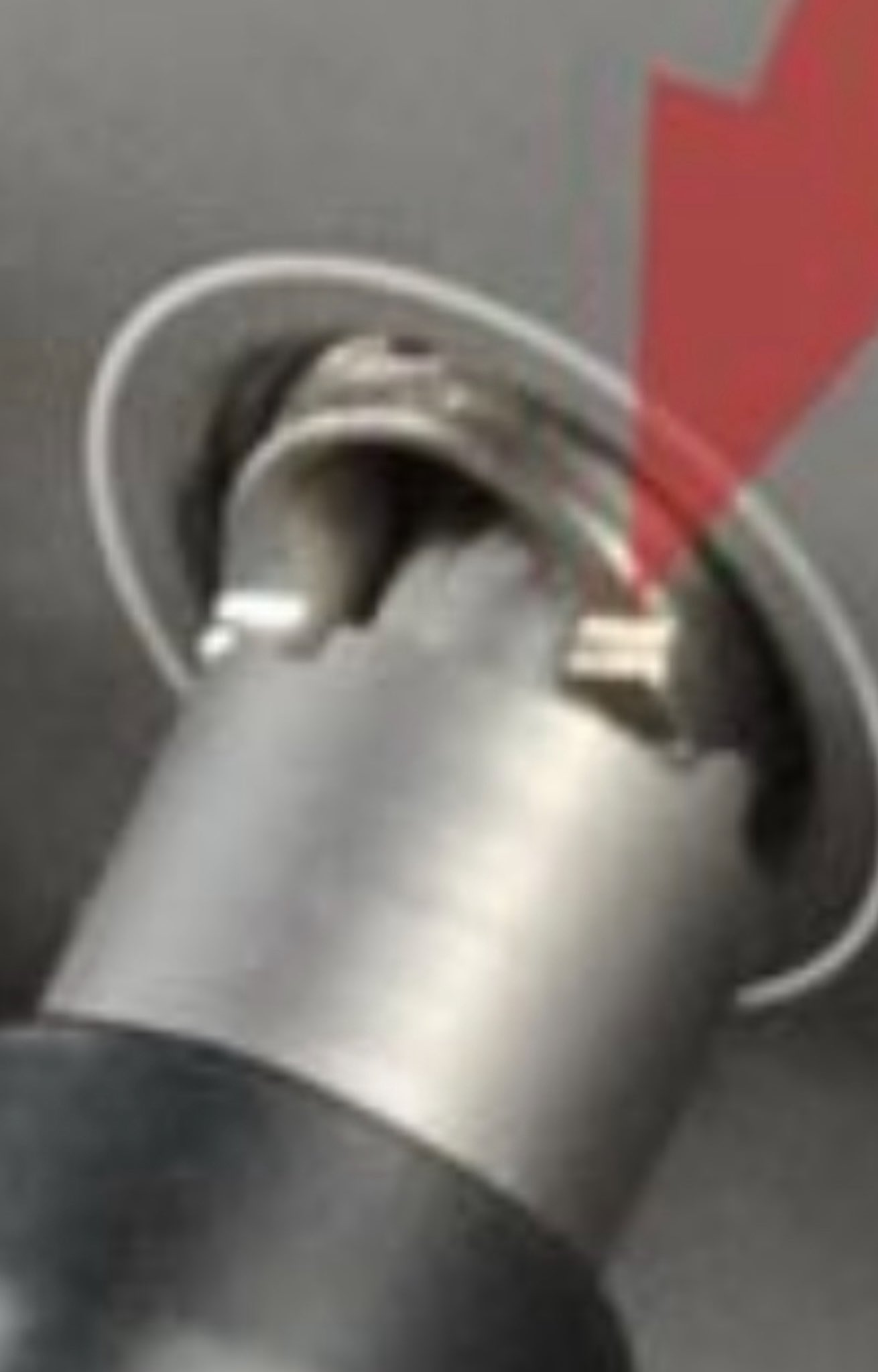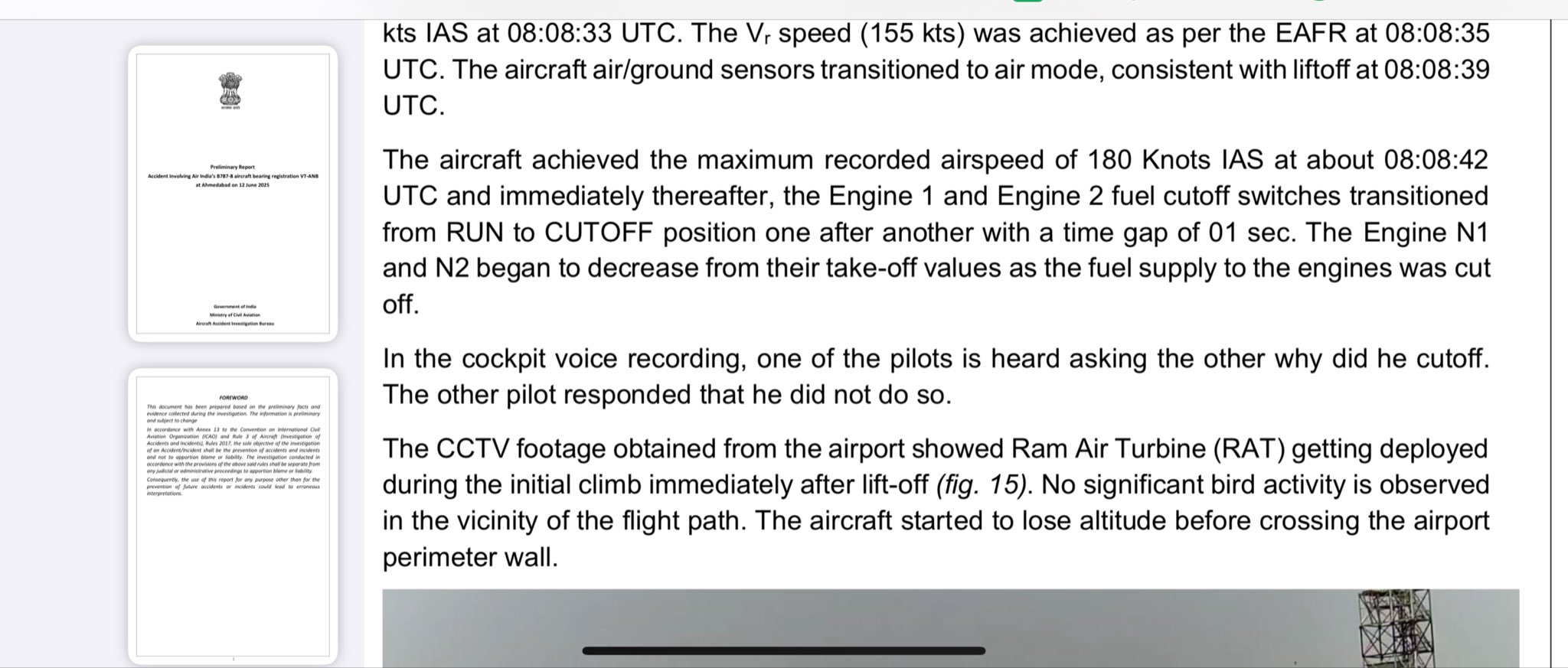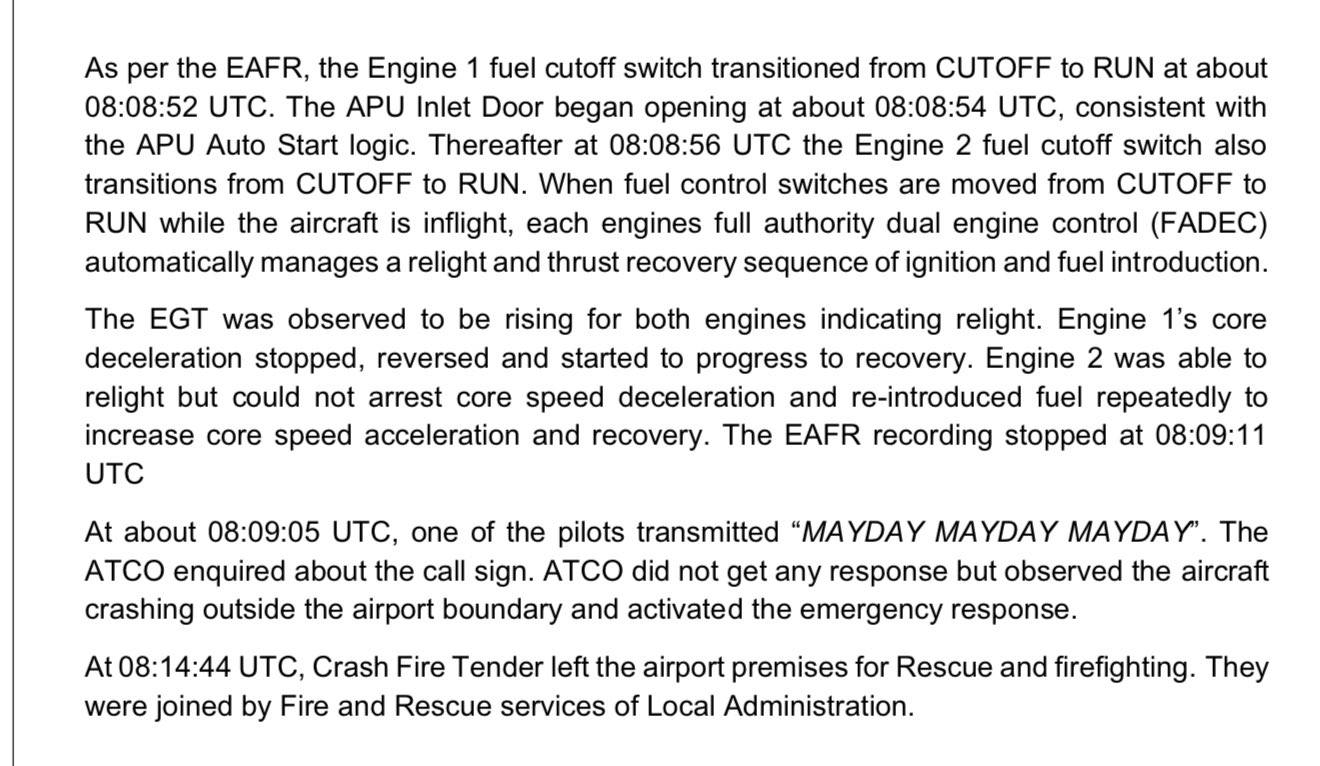Civil Aviation Development & Discussion
Re: Civil Aviation Development & Discussion
"As per the EAFR data, the aircraft crossed the take-off decision speed V1 and achieved 153
kts IAS at 08:08:33 UTC. The Vr speed (155 kts) was achieved as per the EAFR at 08:08:35
UTC. The aircraft air/ground sensors transitioned to air mode, consistent with liftoff at 08:08:39
UTC.
The aircraft achieved the maximum recorded airspeed of 180 Knots IAS at about 08:08:42
UTC and immediately thereafter, the Engine 1 and Engine 2 fuel cutoff switches transitioned
from RUN to CUTOFF position one after another with a time gap of 01 sec. The Engine N1
and N2 began to decrease from their take-off values as the fuel supply to the engines was cut
off.
In the cockpit voice recording, one of the pilots is heard asking the other why did he cutoff.
The other pilot responded that he did not do so.
The CCTV footage obtained from the airport showed Ram Air Turbine (RAT) getting deployed
during the initial climb immediately after lift-off (fig. 15). No significant bird activity is observed
in the vicinity of the flight path. The aircraft started to lose altitude before crossing the airport
perimeter wall.
As per the EAFR data both engines N2 values passed below minimum idle speed, and the
RAT hydraulic pump began supplying hydraulic power at about 08:08:47 UTC.
As per the EAFR, the Engine 1 fuel cutoff switch transitioned from CUTOFF to RUN at about
08:08:52 UTC. The APU Inlet Door began opening at about 08:08:54 UTC, consistent with
the APU Auto Start logic. Thereafter at 08:08:56 UTC the Engine 2 fuel cutoff switch also
transitions from CUTOFF to RUN. When fuel control switches are moved from CUTOFF to
RUN while the aircraft is inflight, each engines full authority dual engine control (FADEC)
automatically manages a relight and thrust recovery sequence of ignition and fuel introduction.
The EGT was observed to be rising for both engines indicating relight. Engine 1’s core
deceleration stopped, reversed and started to progress to recovery. Engine 2 was able to
relight but could not arrest core speed deceleration and re-introduced fuel repeatedly to
increase core speed acceleration and recovery. The EAFR recording stopped at 08:09:11
UTC
At about 08:09:05 UTC, one of the pilots transmitted “MAYDAY MAYDAY MAYDAY”. The
ATCO enquired about the call sign. ATCO did not get any response but observed the aircraft
crashing outside the airport boundary and activated the emergency response
kts IAS at 08:08:33 UTC. The Vr speed (155 kts) was achieved as per the EAFR at 08:08:35
UTC. The aircraft air/ground sensors transitioned to air mode, consistent with liftoff at 08:08:39
UTC.
The aircraft achieved the maximum recorded airspeed of 180 Knots IAS at about 08:08:42
UTC and immediately thereafter, the Engine 1 and Engine 2 fuel cutoff switches transitioned
from RUN to CUTOFF position one after another with a time gap of 01 sec. The Engine N1
and N2 began to decrease from their take-off values as the fuel supply to the engines was cut
off.
In the cockpit voice recording, one of the pilots is heard asking the other why did he cutoff.
The other pilot responded that he did not do so.
The CCTV footage obtained from the airport showed Ram Air Turbine (RAT) getting deployed
during the initial climb immediately after lift-off (fig. 15). No significant bird activity is observed
in the vicinity of the flight path. The aircraft started to lose altitude before crossing the airport
perimeter wall.
As per the EAFR data both engines N2 values passed below minimum idle speed, and the
RAT hydraulic pump began supplying hydraulic power at about 08:08:47 UTC.
As per the EAFR, the Engine 1 fuel cutoff switch transitioned from CUTOFF to RUN at about
08:08:52 UTC. The APU Inlet Door began opening at about 08:08:54 UTC, consistent with
the APU Auto Start logic. Thereafter at 08:08:56 UTC the Engine 2 fuel cutoff switch also
transitions from CUTOFF to RUN. When fuel control switches are moved from CUTOFF to
RUN while the aircraft is inflight, each engines full authority dual engine control (FADEC)
automatically manages a relight and thrust recovery sequence of ignition and fuel introduction.
The EGT was observed to be rising for both engines indicating relight. Engine 1’s core
deceleration stopped, reversed and started to progress to recovery. Engine 2 was able to
relight but could not arrest core speed deceleration and re-introduced fuel repeatedly to
increase core speed acceleration and recovery. The EAFR recording stopped at 08:09:11
UTC
At about 08:09:05 UTC, one of the pilots transmitted “MAYDAY MAYDAY MAYDAY”. The
ATCO enquired about the call sign. ATCO did not get any response but observed the aircraft
crashing outside the airport boundary and activated the emergency response
Re: Civil Aviation Development & Discussion
CVR captures both pilots and cockpit audio on different channels, so investigators know who said what. Regarding deliberate action sounds eeriely similar to Alaska airlines flight 2059.
Re: Civil Aviation Development & Discussion
Here we go
Already Goras are ganging up on the Preliminary Report
Pee pee See first to fire the salvo
Interviewing victims families and blaming the report as no responsibility fixed
Why report released at 1.30 AM Indian time yada yada
Already Goras are ganging up on the Preliminary Report
Pee pee See first to fire the salvo
Interviewing victims families and blaming the report as no responsibility fixed
Why report released at 1.30 AM Indian time yada yada
Re: Civil Aviation Development & Discussion
Highly unusual events seem to have happened in that cockpit going by this report.
Re: Civil Aviation Development & Discussion
Its a preliminary report and preliminary for a reason. They are still investigating and if our braindead media, (including the highly revered Sindoor F16 wale "V") can't be bother to read the six page report in its entirety then not much left to say.
The report is clear that NTSB was also involved in the investigation as were people from Boeing. DGCA said there is no new guidance to either Boeing or GE and they are concentrating on the human element. There is no grand conspiracy but then again our media isn't exactly known for using their brains.
Re: Civil Aviation Development & Discussion
The resident uncle Tom and flag bearer for the Brits Soutik Biswas is covering the tragedy - he is ticking all the checkboxes of disaster ***** and the narrative of how the dirty Indians are incompetent. He is wondering out loud that Indian aviation sector is dangerous - when there are no statistics to back this claim. He then actually gives the example of a flight in turbulence…
Re: Civil Aviation Development & Discussion
YT has a thumbs down button for such trash, please use it.
Re: Civil Aviation Development & Discussion
ANI@ANI
On Aircraft Accident Investigation Bureau's Preliminary Report on 12th June AI 171 crash, Airline Pilots' Association of India says, "The tone and direction of the investigation suggest a bias toward pilot error. We categorically reject this presumption and insist on a fair, fact-based inquiry."
"The report was leaked to media without any responsible official signature or attribution. There is lack of transparency in investigation as investigations continue to be shrouded in secrecy, undermining credibility and public trust. Qualified, experienced personnel, especially line pilots, are still not being included in the investigation team."
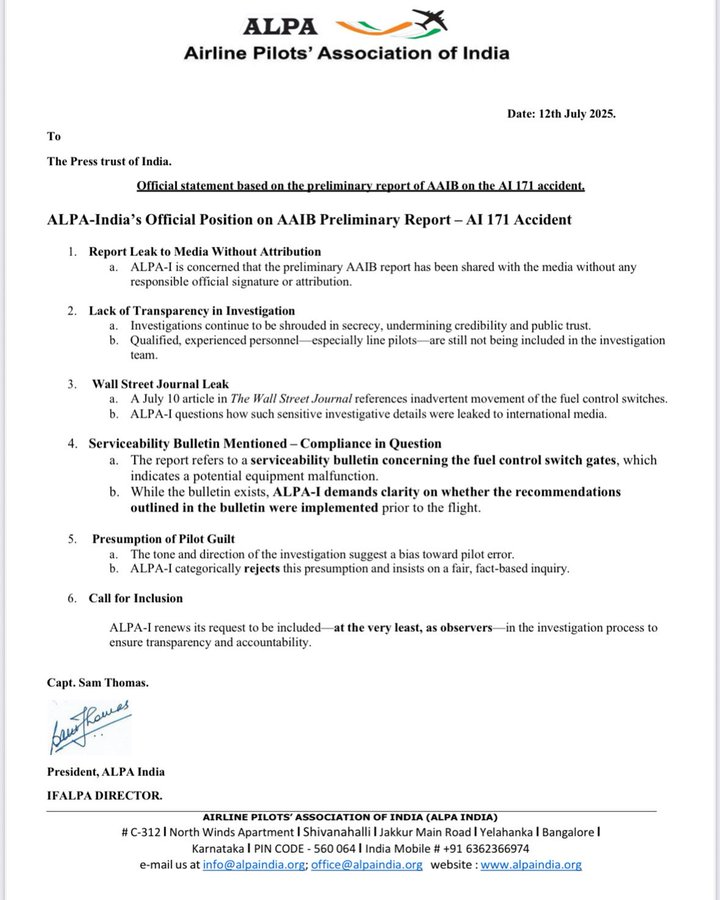
Last edited by chetak on 12 Jul 2025 20:18, edited 1 time in total.
Re: Civil Aviation Development & Discussion
Here below, IMO, is a more useful take on the report.
Reminder: it is a preliminary report, produced in 30 days because of international treaty obligations. It does not give all the detail that the investigators have (for example, the full cockpit voice recording about what was said before the fuel control switches cut off. That will certainly reveal more about the harmony between pilot and co-pilot, their states of mind, etc.).
For future use, keep track of those who go with "dirty Indians are incompetent" and those who give a balanced view of what is a preliminary report. Such is useful to know whom to trust and whom not to. Name names here on BRF.
https://youtu.be/CHmY5oLkTVg?si=58SWNf5VEYsWpFHb
Reminder: it is a preliminary report, produced in 30 days because of international treaty obligations. It does not give all the detail that the investigators have (for example, the full cockpit voice recording about what was said before the fuel control switches cut off. That will certainly reveal more about the harmony between pilot and co-pilot, their states of mind, etc.).
For future use, keep track of those who go with "dirty Indians are incompetent" and those who give a balanced view of what is a preliminary report. Such is useful to know whom to trust and whom not to. Name names here on BRF.
https://youtu.be/CHmY5oLkTVg?si=58SWNf5VEYsWpFHb
Re: Civil Aviation Development & Discussion
FYI, the best demo of the Boeing fuel run/cutoff switches that i have found so far - very short video:
https://youtu.be/33hG9-BCJVQ?si=r77GsQXx3svyFBb1
Also, per the preliminary report, in the airplane wreckage "Both fuel control switch were found in the “RUN” position. (fig.13)".
---
Barkha Dutt has a Youtube titled "Last Conversation of Pilots" - but A said, B responded does not constitute a conversation. Presumably they were talking before that too, e.g., as they went through the takeoff sequence.
https://youtu.be/33hG9-BCJVQ?si=r77GsQXx3svyFBb1
Also, per the preliminary report, in the airplane wreckage "Both fuel control switch were found in the “RUN” position. (fig.13)".
---
Barkha Dutt has a Youtube titled "Last Conversation of Pilots" - but A said, B responded does not constitute a conversation. Presumably they were talking before that too, e.g., as they went through the takeoff sequence.
Re: Civil Aviation Development & Discussion
Chetakji what is your take on this given you have the relevant experience?
The report is a simple statement of facts as far as I can see, is quite well written. The only quibbles I have is that why it was released at 0130 IST rather than in day time and how was the fuel switch angle leaked to the media. Beyond that it seems to be well written: one can argue whether the pilot conversation should have been there as there is no background to it. One thing AIAB is to be contended is that the whole investigation till now has taken place in India…
Re: Civil Aviation Development & Discussion
From retired IAF pilot Augustine Vinod,
https://x.com/mjavinod/status/194392509 ... Bf-9w&s=19
https://x.com/ramana_brf/status/1943876 ... IqQMw&s=19
https://x.com/mjavinod/status/194392509 ... Bf-9w&s=19
LET ME ASK THIS QUESTION TO ALL YOU INTELLIGENT BEINGS OUT THERE
Can you move TWO switches, which has three distinctive actions to switch it on or off?
WITHIN 1 SECOND ?
CAN YOU?
ANSWER ME
Ramana in X,This is the position of the hands of both pilots when allegedly, fuel cut off switches went off within one second of each other.
Anyone who believes that it was done by pilots, need to get their head examined
https://x.com/ramana_brf/status/1943876 ... IqQMw&s=19
What did you find confusing?
The fuel switch cutoff is a latent defect. FAA erred in issuing a SIAB instead of an AD. SIAB is an advisory while AD is mandatory.
Knowing the high consequence of a twin engine failure both FAA and Boeing erred.
Re: Civil Aviation Development & Discussion
Tanaji wrote: ↑12 Jul 2025 20:53Chetakji what is your take on this given you have the relevant experience?
The report is a simple statement of facts as far as I can see, is quite well written. The only quibbles I have is that why it was released at 0130 IST rather than in day time and how was the fuel switch angle leaked to the media. Beyond that it seems to be well written: one can argue whether the pilot conversation should have been there as there is no background to it. One thing AIAB is to be contended is that the whole investigation till now has taken place in India…
Tanaji saar,
This is not the official report. So how much truth and how much hype simply cannot be judged at this stage. So take it with a large bag of salt, unless proved otherwise
this is from Abhijit Iyer-Mitra @Iyervval's tweet
Here is a closeup of the Honeywell manufactured switch in question & the schematic of how it has to be lifted by 2.28 mm. It would require at least 5 deliberate actions to cut off fuel to both engines
The crucial part. It says the fuel control SWITCH TRANSITIONED (Not that the fuel cut off automatically, which happened in response to the switch transitioning). The switch can’t automatically transition. It has a hard metal gate - it has to first be pulled up & then moved
The preliminary report into the Ahmadabad Air India crash confirms dual engine cutoff. One engine recovered completely- the other only partially. Dual engine failure is almost an impossibility in this day and age. The question is how did it happen? Maintenance? Software? Design?
Re: Civil Aviation Development & Discussion
Why would any system allow two CRITICAL switches to be turned off without giving a loud audio/visual warning?
Re: Civil Aviation Development & Discussion
Chetak, Hriday.. thanks..
FWIW .. some wild SPECULATIONS.. (Ignore it - may be long as we would know )
)
Not saying this is what happened, but maybe worth flagging a few things—just in case someone’s investigating all angles. Yeah, some of this is speculative, but modern fly-by-wire systems, even the “what ifs” deserve a closer look.
- Old or faulty switches?
787s are packed with electronics—if any switch, circuit breaker, or power panel is getting worn or misbehaving (or worse, tampered with), it could set off cascading failures. There’ve been Boeing service notices before on power distribution issues. Something like that acting up at the wrong time? (One airline pilot suggested this)
- Malicious access by a local technician?
Software updates or system maintenance are sometimes done by third-party staff or local contractors. All it takes is one bad actor with access to a USB port or config console to mess with stuff—intentionally or not.
- Who handles software security for Boeing planes?
The main cybersecurity work for Boeing—especially software security assessments—is usually done in-house through Boeing Intelligence & Analytics (BI&A), and previously through Narus, a cybersecurity firm Boeing acquired. But here’s the thing: in many real-world situations, especially abroad, airlines sometimes rely on local companies for diagnostics, software uploads, or ground-based system support. That opens the door, even if slightly, to missteps or manipulation outside Boeing’s direct control. Worth checking who exactly handled any recent updates or maintenance on the affected aircraft.
- Compromised firmware from a vendor?
787 systems rely on hardware and code from dozens of suppliers. If even one of those suppliers was compromised, or pushed a firmware update that got past QA, it could open a hidden vulnerability. Unlikely? Maybe. But after SolarWinds and similar hacks, it’s not crazy to ask.
.
- Bad or incomplete software update?
If some critical system was halfway through a software update or config tweak, and it wasn’t caught before takeoff,... That happens more often than people think—with ground systems too.
- Deliberate test or probe?
And okay, this is really speculative—but what if someone was testing whether they could trigger something without actually crashing the plane? Red-team gone rogue, or worse, a state-level actor probing systems quietly?
Again—not claiming this is what happened. But hopefully someone’s looking into all these angles. With something as complex as the 787, especially in a mixed operating environment like Air India’s (global suppliers, local ground crews, aging aircraft), it’s better to cast a wide net early than wait till something bigger goes wrong....
(We know that switches were actually moved - pilots confirmed it - so something mechanical (induced may be) did happen to switched the positions (requires deliberate actionon))
FWIW .. some wild SPECULATIONS.. (Ignore it - may be long as we would know
Not saying this is what happened, but maybe worth flagging a few things—just in case someone’s investigating all angles. Yeah, some of this is speculative, but modern fly-by-wire systems, even the “what ifs” deserve a closer look.
- Old or faulty switches?
787s are packed with electronics—if any switch, circuit breaker, or power panel is getting worn or misbehaving (or worse, tampered with), it could set off cascading failures. There’ve been Boeing service notices before on power distribution issues. Something like that acting up at the wrong time? (One airline pilot suggested this)
- Malicious access by a local technician?
Software updates or system maintenance are sometimes done by third-party staff or local contractors. All it takes is one bad actor with access to a USB port or config console to mess with stuff—intentionally or not.
- Who handles software security for Boeing planes?
The main cybersecurity work for Boeing—especially software security assessments—is usually done in-house through Boeing Intelligence & Analytics (BI&A), and previously through Narus, a cybersecurity firm Boeing acquired. But here’s the thing: in many real-world situations, especially abroad, airlines sometimes rely on local companies for diagnostics, software uploads, or ground-based system support. That opens the door, even if slightly, to missteps or manipulation outside Boeing’s direct control. Worth checking who exactly handled any recent updates or maintenance on the affected aircraft.
- Compromised firmware from a vendor?
787 systems rely on hardware and code from dozens of suppliers. If even one of those suppliers was compromised, or pushed a firmware update that got past QA, it could open a hidden vulnerability. Unlikely? Maybe. But after SolarWinds and similar hacks, it’s not crazy to ask.
.
- Bad or incomplete software update?
If some critical system was halfway through a software update or config tweak, and it wasn’t caught before takeoff,... That happens more often than people think—with ground systems too.
- Deliberate test or probe?
And okay, this is really speculative—but what if someone was testing whether they could trigger something without actually crashing the plane? Red-team gone rogue, or worse, a state-level actor probing systems quietly?
Again—not claiming this is what happened. But hopefully someone’s looking into all these angles. With something as complex as the 787, especially in a mixed operating environment like Air India’s (global suppliers, local ground crews, aging aircraft), it’s better to cast a wide net early than wait till something bigger goes wrong....
(We know that switches were actually moved - pilots confirmed it - so something mechanical (induced may be) did happen to switched the positions (requires deliberate actionon))
Last edited by Amber G. on 12 Jul 2025 22:03, edited 1 time in total.
Re: Civil Aviation Development & Discussion
Just asking a dumb question: why allow engines to be turned of during flight. I don't see the need to ever turn of engines in flight for a commercial aircraft. Are there some situations which warrants a turn off engines during flight? If there are none, the act of switch off engines in altitude should be disbarred and/or ignored by the controls.
Re: Civil Aviation Development & Discussion
AI says:
Reasons for Turning Engines Off:
Engine Failure:
If an engine malfunctions or loses power, a pilot may need to shut it down to prevent further damage or to allow for a restart if possible.
Emergency Situations:
In rare cases, an engine fire or other emergency may require an immediate engine shutdown for safety.
Fuel Conservation:
On longer flights, pilots may shut down one or more engines during cruise to reduce fuel consumption, especially in aircraft designed for such operations.
Reasons for Turning Engines Off:
Engine Failure:
If an engine malfunctions or loses power, a pilot may need to shut it down to prevent further damage or to allow for a restart if possible.
Emergency Situations:
In rare cases, an engine fire or other emergency may require an immediate engine shutdown for safety.
Fuel Conservation:
On longer flights, pilots may shut down one or more engines during cruise to reduce fuel consumption, especially in aircraft designed for such operations.
Re: Civil Aviation Development & Discussion
A pilot has made a video and posted on reddit of him moving both switches to off position one after another and it took no more than 2 seconds. Now if someone wants to do it in a hurry and grabs both switches at once then it is possible to move them simultaneously to cutoff in a second.Hriday wrote: ↑12 Jul 2025 21:10 From retired IAF pilot Augustine Vinod,
https://x.com/mjavinod/status/194392509 ... Bf-9w&s=19LET ME ASK THIS QUESTION TO ALL YOU INTELLIGENT BEINGS OUT THERE
Can you move TWO switches, which has three distinctive actions to switch it on or off?
WITHIN 1 SECOND ?
CAN YOU?
ANSWER MERamana in X,This is the position of the hands of both pilots when allegedly, fuel cut off switches went off within one second of each other.
Anyone who believes that it was done by pilots, need to get their head examined
https://x.com/ramana_brf/status/1943876 ... IqQMw&s=19What did you find confusing?
The fuel switch cutoff is a latent defect. FAA erred in issuing a SIAB instead of an AD. SIAB is an advisory while AD is mandatory.
Knowing the high consequence of a twin engine failure both FAA and Boeing erred.
As for the FAA SAIB-NM-18-33, nowhere does it mention switches moving to cutoff position by itself during operation! If that were to be the case, all Boeings with similar switches would have been grounded immediately! It is an advisory that says the Boeing Company received reports from operators of Model 737 airplanes that the fuel control switches were installed with the locking feature disengaged. Each switch is controlled independently with built in redundancy, both engine switches cannot move to cutoff positions unless they are physically moved, lock or no lock!
Re: Civil Aviation Development & Discussion
Thanks. But these situations, warrant 2 step process with "Are you sure?" type question for engine shut off.A_Gupta wrote: ↑12 Jul 2025 22:00 AI says:
Reasons for Turning Engines Off:
Engine Failure:
If an engine malfunctions or loses power, a pilot may need to shut it down to prevent further damage or to allow for a restart if possible.
Emergency Situations:
In rare cases, an engine fire or other emergency may require an immediate engine shutdown for safety.
Fuel Conservation:
On longer flights, pilots may shut down one or more engines during cruise to reduce fuel consumption, especially in aircraft designed for such operations.
Re: Civil Aviation Development & Discussion
Found this comment online. Something for the investigators to check on a 787 of similar age.
it will be interesting to hear the cockpit voice recorder at the time of engines start to see if the switches were actually slid past the detent with the characteristic, loud "click". If the engines can be fed fuel before the mechanical gate has been passed, it may have been just waiting for vibration to jar it either way. The heaviest vibration is at takeoff speed. Don't know if it will run before dropping into the gate. I always gave it a little tug.
Is this switch design similar in other airliners, or unique to the 787? Assuming you've flown this model? How much physical effort does it take to move the switch from run to cut? Is it possible this gets easier with repeated use?
Re: Civil Aviation Development & Discussion
Hriday wrote: ↑12 Jul 2025 21:10 From retired IAF pilot Augustine Vinod,
https://x.com/mjavinod/status/194392509 ... Bf-9w&s=19LET ME ASK THIS QUESTION TO ALL YOU INTELLIGENT BEINGS OUT THERE
Can you move TWO switches, which has three distinctive actions to switch it on or off?
WITHIN 1 SECOND ?
CAN YOU?
ANSWER MERamana in X,This is the position of the hands of both pilots when allegedly, fuel cut off switches went off within one second of each other.
Anyone who believes that it was done by pilots, need to get their head examined
https://x.com/ramana_brf/status/1943876 ... IqQMw&s=19What did you find confusing?
The fuel switch cutoff is a latent defect. FAA erred in issuing a SIAB instead of an AD. SIAB is an advisory while AD is mandatory.
Knowing the high consequence of a twin engine failure both FAA and Boeing erred.
Hriday ji,
we have our very own aviation reincarnation of khujliwal, the so called capt m0h@n r@ng@n@th@n, the dirtbag, and one of the "Wrong brothers" who has already emphatically declared this as a deliberate pilot initiated action to cause the crash.
wonder what the going $ rate for 13 p!ece$ of silver is these days and whether trump tariff of 165% would apply to this precious metal import from the the land of the (w)right brothers
It takes a certain amount of ingrained evil to be so very disloyal to your own tribe.
Re: Civil Aviation Development & Discussion
FAA Aviation Safety SPECIAL AIRWORTHINESS INFORMATION BULLETIN
UBJ: Engine Fuel and Control
SAIB: NM-18-33
Date: December 17, 2018
Uploaded onto Google drive.
https://drive.google.com/file/d/1NA4Gps ... sp=sharing
If so,, what if someone disengaged the locking mechanism?
If this is a valid failure mechanism, only then need we start speculating on who could have caused this disengagement.
UBJ: Engine Fuel and Control
SAIB: NM-18-33
Date: December 17, 2018
Uploaded onto Google drive.
https://drive.google.com/file/d/1NA4Gps ... sp=sharing
The Boeing Company (Boeing) received reports from operators of Model 737 airplanes that the fuel control switches were installed with the locking feature disengaged. The fuel control switches (or engine start switches) are installed on the control stand in the flight deck and used by the pilot to
supply or cutoff fuel to the engines. The fuel control switch has a locking feature to prevent inadvertent operation that could result in unintended switch movement between the fuel supply and fuel cutoff positions. In order to move the switch from one position to the other under the condition
where the locking feature is engaged, it is necessary for the pilot to lift the switch up while transitioning the switch position. If the locking feature is disengaged, the switch can be moved between the two positions without lifting the switch during transition, and the switch would be exposed to the potential of inadvertent operation. Inadvertent operation of the switch could result in an unintended consequence, such as an in-flight engine shutdown.
Apparently uel control switch locking mechanism can be disengaged -- it needs to be examined if an engaged locking mechanism can be disengaged.The FAA recommends that all owners and operators of the affected airplanes incorporate the following actions at the earliest opportunity:
1) Inspect the locking feature of the fuel control switch to ensure its engagement. While the airplane is on the ground, check whether the fuel control switch can be moved between the two positions without lifting up the switch. If the switch can be moved without lifting it up, the locking feature has been disengaged and the switch should be replaced at the earliest opportunity.
If so,, what if someone disengaged the locking mechanism?
If this is a valid failure mechanism, only then need we start speculating on who could have caused this disengagement.
Re: Civil Aviation Development & Discussion
Not sufficient to have mechnical barriers which are easy to operate and override. (If mechanical vibrations can flip it then it is even more dangerous having just mechanical barriers) We need more prevention of such a thing to happen in flight especially. Things like fire in engine can be monitored by sensors and allow for switch off if required by the pilot and even then that must be done in a multi step manner.
Just anecdote: Steve Jobs of Apple Computer Inc. was obsessed with not providing an OFF switch for computers. He initially worked at HP which had computers with built in power fail recovery circuit, i.e. you switch it off or pull the power plug but it does not shown down, requires further steps to bring it to "OFF" condition. In Apple Mac Books the power switch has be kept depressed for some time to reboot the system.
Aircraft engine operation is vital for its flight and having human errors must be minimized to a large degree.
Re: Civil Aviation Development & Discussion
The toggle switch is Honeywell 4TL837-3D.
Datasheet for this and related switches is here:
https://www.mouser.com/datasheet/2/187/ ... 735572.pdf
If one could buy a single instance of it, it is not expensive. Then one could take it apart and satisfy oneself whether the locking mechanism can be disengaged without perceptible damage to the switch.
Unfortunately, it is out of stock at the places where a single instance can be bought. At other places it must be bought in multiples of 50, and likely they won't sell to an individual.
Datasheet for this and related switches is here:
https://www.mouser.com/datasheet/2/187/ ... 735572.pdf
If one could buy a single instance of it, it is not expensive. Then one could take it apart and satisfy oneself whether the locking mechanism can be disengaged without perceptible damage to the switch.
Unfortunately, it is out of stock at the places where a single instance can be bought. At other places it must be bought in multiples of 50, and likely they won't sell to an individual.
Re: Civil Aviation Development & Discussion
Augustine Vinod is at least 50% right. The Pilot flying (in this case the less experienced co-pilot) cannot be toggling the fuel control switches because he has his hands holding the yoke and would be pulling it towards himself since we are still in the take off phase.
For the remaining 50% we have to go to the Pilot Monitoring (in this case the highly experienced pilot in charge). His yoke would be moving too because of the actions of Pilot Flying, but he could, in theory, take his hands off the yoke and do something else, like toggling the fuel switches to off position. But why the heck would he do that?
There is a 8-12 seconds elapsed time between the fuel switches going to off position and back to run (ON). What happened during those precious seconds?
In the cockpit voice recording, one of the pilots is heard asking the other why did he cutoff.
The other pilot responded that he did not do so. Who said what here? Pilot Flying or Pilot Monitoring? The preliminary report has some ambiguities. Why not publish the full transcript?
The full CVR conversation with timestamps juxtaposed against the DFDR event logs second by second will help us elucidate this mystery. Hopefully.
For the remaining 50% we have to go to the Pilot Monitoring (in this case the highly experienced pilot in charge). His yoke would be moving too because of the actions of Pilot Flying, but he could, in theory, take his hands off the yoke and do something else, like toggling the fuel switches to off position. But why the heck would he do that?
There is a 8-12 seconds elapsed time between the fuel switches going to off position and back to run (ON). What happened during those precious seconds?
In the cockpit voice recording, one of the pilots is heard asking the other why did he cutoff.
The other pilot responded that he did not do so. Who said what here? Pilot Flying or Pilot Monitoring? The preliminary report has some ambiguities. Why not publish the full transcript?
The full CVR conversation with timestamps juxtaposed against the DFDR event logs second by second will help us elucidate this mystery. Hopefully.
Re: Civil Aviation Development & Discussion
Indian pilot Sam Thomas points out that the emergency procedure in case both engines lose thrust is to toggle the fuel control switches. That is, you flip the fuel flow off and the on again.
So, if the engines lost thrust the sequence with the fuel flow switches is what is expected. The exact timing of what one pilot said to the other vs these switch flips is important.
So, if the engines lost thrust the sequence with the fuel flow switches is what is expected. The exact timing of what one pilot said to the other vs these switch flips is important.
Re: Civil Aviation Development & Discussion
What telemetry is recorded? Switch position from the switch itself or from some fuel pump controller/ECU?
Re: Civil Aviation Development & Discussion
Basic design philosophy of cockpit architecture is descried in these papers quoted. You will find many clarification to why this was designed the way it was.
https://ntrs.nasa.gov/api/citations/199 ... 016374.pdf
https://www.aviationtoday.com/2005/11/0 ... bold-move/
https://iopscience.iop.org/article/10.1 ... 012037/pdf
Re: Civil Aviation Development & Discussion
The Prime Minister took interest in this accident probe, did he not, directing that the flight recorders remain in India? If so, the preliminary report is from the people of the caliber who brought us Op Sindoor, IMO, and not some sleepy babus, IMO. The more I think about it, the more ambiguous the report is. It leads you to an inference about the cause of the accident, but actually there is nowhere enough information to make any inference. The report does not tell any untruths, but the amount of relevant facts it doesn't mention is huge.
Why such a report? One possibility is that the Government of India does not want to embarrass the American aerospace establishment, and by extension Trump, while some delicate negotiations are going on about trade or something else.
Why such a report? One possibility is that the Government of India does not want to embarrass the American aerospace establishment, and by extension Trump, while some delicate negotiations are going on about trade or something else.
Re: Civil Aviation Development & Discussion
Okay. May explain why the report did not include a transcript of the CVR. There certainly was some coordination with the US, since the report was released almost exactly after the US markets closed for the day.
At the same time, the report does not call for any updates to equipment in use today. Most likely they haven't formed a concrete opinion yet.
At the same time, the report does not call for any updates to equipment in use today. Most likely they haven't formed a concrete opinion yet.
Re: Civil Aviation Development & Discussion
Exactly my doubt as well. Switch positions can be seen only if there are pictures. Am I correct in saying that CVR and FDR do not have any imaging capability? My understanding is that they record voice and sensor data. I can understand why video is not there. But why not record images of the cockpit during take off and landing? Those are almost always the critical periods for the aircraft.
Re: Civil Aviation Development & Discussion
I was about to ask the same question but I thought of one situation when such a measure maybe needed. What if somebody notices a fire in one or both engines? Then the first step is to starve the fire of the fuel. This could happen while the aircraft is taxiing for take off or landing. If it blows up on the runway, many other aircraft following them would be in jeopardy.bala wrote: ↑12 Jul 2025 21:51 Just asking a dumb question: why allow engines to be turned of during flight. I don't see the need to ever turn of engines in flight for a commercial aircraft. Are there some situations which warrants a turn off engines during flight? If there are none, the act of switch off engines in altitude should be disbarred and/or ignored by the controls.
Re: Civil Aviation Development & Discussion
Apparently, there are reasons that engines get turned off to save fuel.
Airline pilots, what fuel saving measures does your airline implement?
Airline pilots, what fuel saving measures does your airline implement?
Re: Civil Aviation Development & Discussion
That is not an emergency situation. There should be majority voting in that case, i.e. both pilots in agreement, i.e. two sets switches and only when autopilot is engaged. Also in this day and age it should be possible to detect conditions under which fuel supply can be reduced but not completely cutoff. These switches are binary - full fuel flow or none at all.vera_k wrote: ↑13 Jul 2025 06:23 Apparently, there are reasons that engines get turned off to save fuel.
Airline pilots, what fuel saving measures does your airline implement?
Re: Civil Aviation Development & Discussion
Plane has to be able to fly if one of the pilots falls ill though. The industry has been moving towards fewer pilots in the cockpit for a long time. So perhaps complete autopilot flights may be a solution.
Re: Civil Aviation Development & Discussion
From today's Manorama newspaper front page,; both fuel control switches went off in an interval of 1 second. But when both switches were turned on after 10 second the interval time between two switches were 4 seconds. See the screenshot of the report below. I think it suggests that even with the emergency pilots took 4 seconds to turn on both switches. So it looks like IAF pilot Augustine Vinod is correct that just 1 second interval is not man made.
I wonder why this 4 seconds delay didn't get the attention it deserves in the media earlier?

I wonder why this 4 seconds delay didn't get the attention it deserves in the media earlier?

Re: Civil Aviation Development & Discussion
Expert Claims Pilot May Have Deliberately Crashed Air India Flight
many Indian airlines and even the Directorate General of Civil Aviation (DGCA) have failed to adopt mental health safeguards for pilots, despite repeated warnings.
Re: Civil Aviation Development & Discussion
There was no video recording - the option is available for 787 but was not exercised. NTSB had suggested video feeds be sent to CVR but could not mandate it due to objections from the pilot lobby.Vayutuvan wrote: ↑13 Jul 2025 06:13Exactly my doubt as well. Switch positions can be seen only if there are pictures. Am I correct in saying that CVR and FDR do not have any imaging capability? My understanding is that they record voice and sensor data. I can understand why video is not there. But why not record images of the cockpit during take off and landing? Those are almost always the critical periods for the aircraft.
The report is remarkable for being thorough and not commenting on other aspects. I suspect that by the time they did not have enough information to say conclusively one or the other.
We don’t know if the switch is a physical switch or just one masquerading for a software one. I suspect it’s the latter.
